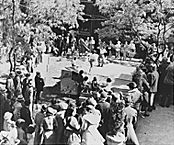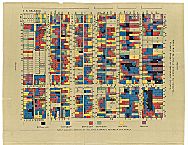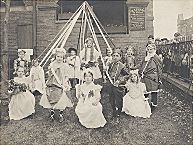What Were Services Were Offered In Settlement Houses
| Entries |
| S |
| Settlement Houses |
 |
The settlement idea appealed to immature Americans who wished to span the gulf of course, help the urban poor, implement "social Christianity," and understand the causes of poverty. Stanton Coit, who lived at Toynbee Hall for several months, opened the offset American settlement in 1886, Neighborhood Society on the Lower East Side of New York. In 1889, Jane Addams and Ellen Gates Starr launched Hull House in Chicago. As discussion of these experiments spread, other settlements appeared in New York, Boston, Philadelphia, and Chicago. Hull Firm inspired Charles Zueblin to organize Northwestern University Settlement in 1891. The post-obit twelvemonth, Graham Taylor started Chicago Eatables and Mary McDowell took charge of University of Chicago Settlement near the stockyards. By 1900, there were more than 100 settlements in America; xv were in Chicago. Eventually there were more 400 settlements nationwide. The nearly active and influential ones were in the large cities of the Northeast and Midwest.
Different their British counterparts, American settlements were in neighborhoods populated by recent European immigrants, few of whom spoke English. Thus the first outreach was to children and mothers, through twenty-four hours care nurseries, kindergartens, and pocket-sized play lots. Mothers' clubs, English classes, and groups interested in arts, crafts, music, and drama followed. The early residents paid room and board, and volunteered equally group leaders or teachers. Equally their numbers increased and programs expanded, the settlements incorporated and trustees raised money to purchase or build larger quarters. These structures accommodated gymnasiums, auditoriums, classrooms, and meeting halls, equally well equally living space and communal dining facilities for a dozen or more than residents. Settlements welcomed meetings of merchandise unions, ethnic groups, and borough organizations. Some established country summer camps, and a few adult their music programs into serious schools. Many exchanged information through metropolis federations, the showtime of which was established past the Chicago settlements in 1894. Approximately half of the American settlements, usually the smaller ones, had religious sponsors and comparatively pocket-sized programs. The remainder eschewed religious orientation because it was bound to offend at least some of their neighbors.
 |
 |
In Chicago, Hull Firm was displaced by a new university campus; closure of the stockyards and packinghouses undermined the Academy of Chicago Settlement; a new throughway destroyed much of the Chicago Eatables neighborhood; and the Chicago Federation of Settlements expired in the 1980s. However, the Chicago Eatables Clan (1948–) and Hull House Association (1962–), both loose federations of former settlements, neighborhood centers, and social service agencies, perpetuate the names and at least some of the aspirations of the original settlement houses.
Bibliography
Carson, Mina. Settlement Folk: Social Idea and the American Settlement Move, 1885–1930. 1990.
Davis, Allen F. Spearheads for Reform: The Social Settlements and the Progressive Motion, 1890–1914. 1967.
Trolander, Judith Ann. Professionalism and Social Alter: From the Settlement House Movement to Neighborhood Centers, 1886 to the Nowadays. 1987.
The Electronic Encyclopedia of Chicago © 2005 Chicago Historical Society.
The Encyclopedia of Chicago © 2004 The Newberry Library. All Rights Reserved. Portions are copyrighted by other institutions and individuals. Boosted data on copyright and permissions.
What Were Services Were Offered In Settlement Houses,
Source: https://encyclopedia.chicagohistory.org/pages/1135.html
Posted by: schaffersinut1943.blogspot.com


0 Response to "What Were Services Were Offered In Settlement Houses"
Post a Comment